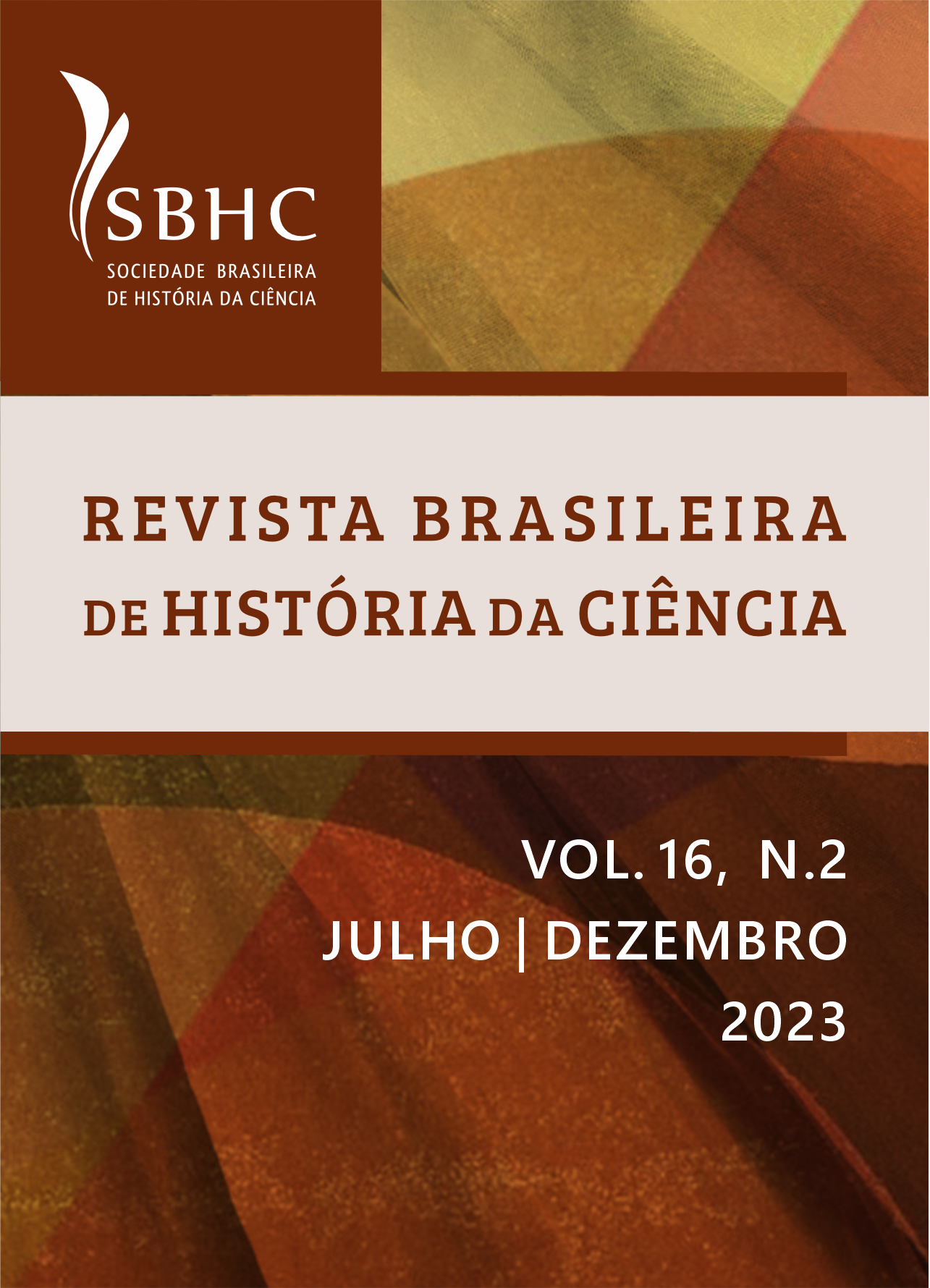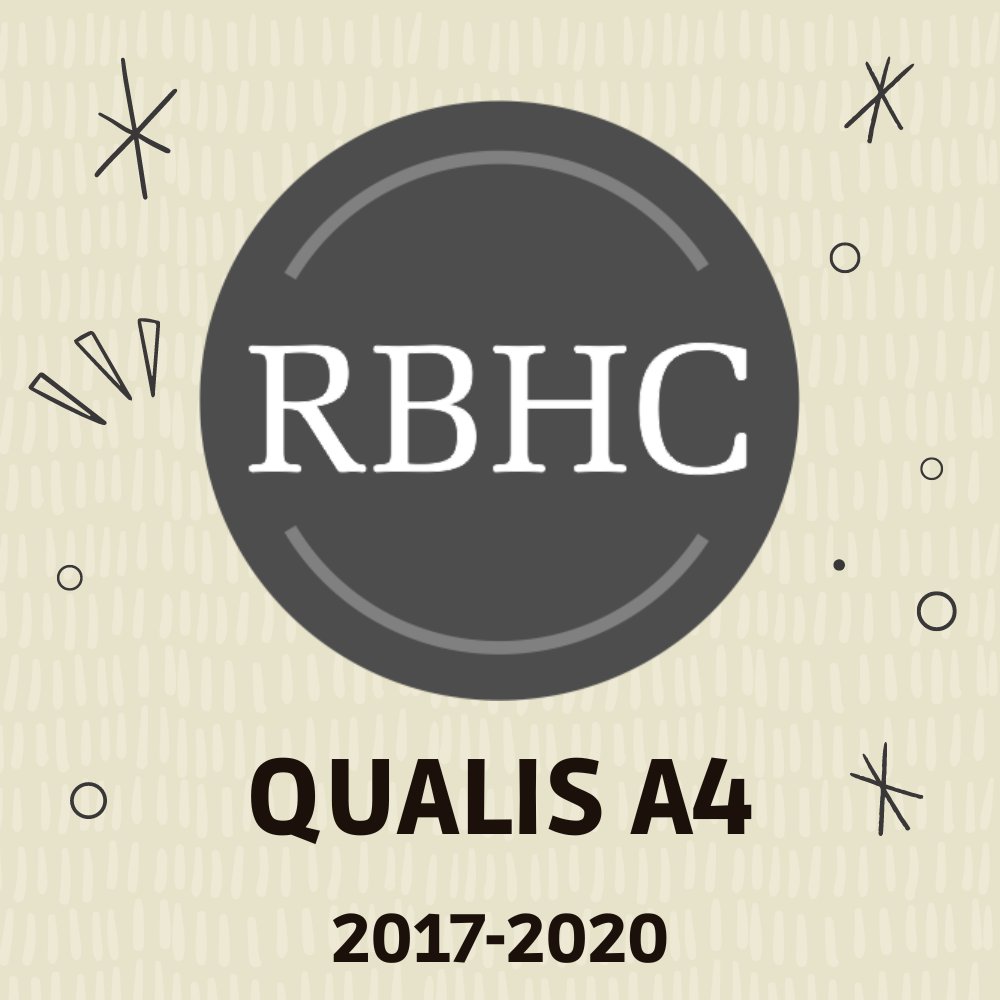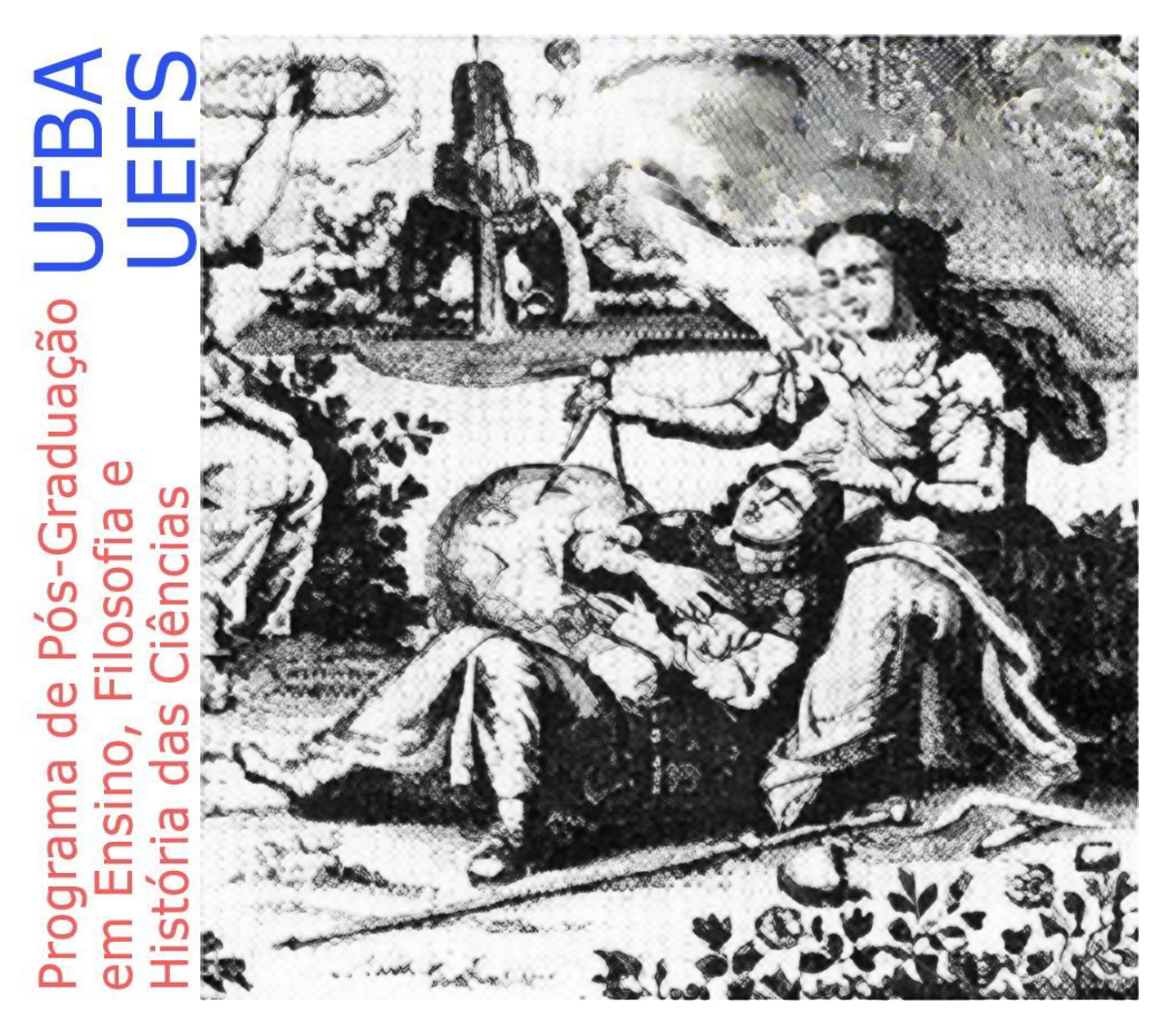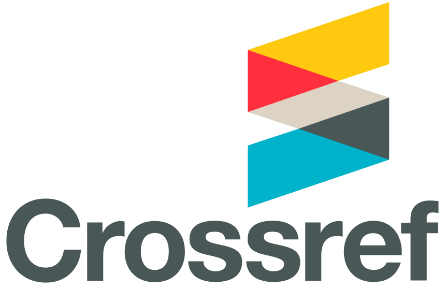“Aventuras no coração do átomo” (1956)
comics, nuclear energy and historical-cultural contexts
DOI:
https://doi.org/10.53727/rbhc.v16i2.894Keywords:
comics , nuclear energy , cultural history of science , textualizationAbstract
From a historical and cultural perspective articulated to the notion of textualization, this article presents an analysis of the production and circulation of the comic book (comics) “Aventuras no coração do átomo” (1956), published in a period in which an entanglement of actors/agencies and interests in relation to nuclear issues was being sewn. The analysis highlighted several aspects: the erasure of the atomic bomb and of agencies involved in the production of the comic, such as the Atomic Energy Commission and the United States Information Agency (USIA); circulation in other countries, including Brazil, favored by UNESCO and USIA as a good example of educational comics; how the comic became one of the instruments of the Atoms for Peace program.
Downloads
References
ADAMSON, M.; TURCHETTI, S. Friends in fission: US-Brazil relations and the global stresses of atomic energy, 1945-1955. Centaurus, v. 63, n. 1, p. 51-66, 2021. DOI: https://doi.org/10.1111/1600-0498.12336
ADVENTURES inside the atom. GE Adventures in Science, 1948.
ANDRADE, A.M.R. A opção nuclear: 50 anos rumo à autonomia. Rio de Janeiro: Mast, 2006.
ANDRADE, A.M.R.; SANTOS, T.L. A dinâmica política da criação da Comissão Nacional de Energia Nuclear, 1956-1960. Boletim do Museu Paraense Emílio Goeldi. Ciências Humanas. v. 8, n. 1, p. 113-128, 2013. DOI: https://doi.org/10.1590/S1981-81222013000100007
A SOCIAL BOOST for comics. GE Adventures Ahead, Jan.-Feb. 1953.
AVENTURAS no coração do átomo. Ciência em Quadrinhos, Rio de Janeiro, n. 19, jul.-ago. 1956.
AVERY, D.V. Tomorrow’n engineers read the comics. General Electric Review, Sept. 1953.
BARBOSA, A.V.A. Histórias em quadrinhos sobre a história do Brasil em 1950: a narrativa dos artistas da Ebal e outras editoras. Dissertação (Mestrado em Ciência da Comunicação) – Universidade de São Paulo, São Paulo, 2006.
BENSAUDE-VINCENT, B. Textbooks on the map of Science Studies. Science & Education, v. 15, p. 667-670, 2006. DOI: https://doi.org/10.1007/s11191-005-1243-1
BOSSE, A.L. Our friend the atom? The Truman administration and the campaign to sell the peaceful atom, 1945-1949. Doctoral Thesis (PhD in History) – California State University, Chico, 2013.
BOYER, P. By the bomb's early light: American thought and culture at the dawn of the Atomic Age. New York: Pantheon, 1985.
BURKE, P. O que é história cultural? Rio de Janeiro: Zahar, 2005.
COMIC STRIPS must be taken seriously. Unesco Courier, v. III, n. 2, p. 9, 1950.
CONVERSA do redator. Edição Maravilhosa, Rio de Janeiro, n. 114, dez. 1955.
EDUCATION is no joke. GE The Monogram, June 1956.
EXPOSIÇÕES no Parque do Ibirapuera. Correio da Manhã, Rio de Janeiro, 4 out. 1955.
GIDZAK, B.C. Atomic Science Education for the American Public, 1945-1949. Doctoral Thesis (PhD in Philosophy) – University of Minnesota, Minneapolis, 2020.
GLASHEEN, G.L. The adult meets and tries to understand the atom. The Journal of Educational Sociology, v. 22, n. 5, p. 339-356, 1949.
GONÇALO JÚNIOR. A guerra dos gibis: a formação do mercado editorial brasileiro e a censura aos quadrinhos, 1933-1964. São Paulo: Companhia das Letras, 2004.
GUILHERME, O. O Brasil e a era atômica. 2 ed. Rio de Janeiro: Vitória, 1957.
HOT OFF THE PRESS. GE The Monogram, Oct. 1954.
INSIDE the atom. GE Adventures in Science, 1955.
JACQUES, V.; SILVA, H.C. A história em quadrinho “Dagwood consegue cindir o átomo” (1950): uma perspectiva histórica e cultural. APEduC Revista: Investigação e Práticas em Educação em Ciências, Matemática e Tecnologia, v. 4, n. 1, p. 27-44, 2023.
JESUS, D.S.V. Autonomia pela contradição: as políticas externa e nuclear de Vargas e JK. Revista Política Hoje, v. 20, n. 2, p. 829-853, 2011.
KAISER, D. A tale of two textbooks: Experiments in genre. Isis, v. 103, n. 1, p. 126-138, 2012. DOI: https://doi.org/10.1086/664983
KNORR-CETINA, K.D. A comunicação na ciência. In: GIL, F. A ciência tal qual se faz. Lisboa: João Sá da Costa, 1999. p. 375-393.
KURAMOTO, R.Y.R.; APPOLONI, C.R. Uma breve história da política nuclear brasileira. Caderno Brasileiro de Ensino de Física, v. 19, n. 3, p. 379-392, 2002.
LUYTEN, S.M.B. O que é história em quadrinhos. 2 ed. São Paulo: Brasiliense. 1987.
MOTOYAMA, S. Álvaro Alberto e a energia nuclear. In: MOTOYAMA, S.; GARCIA, J.C.V. (orgs.) O almirante e o novo Prometeu: Álvaro Alberto e a C&T. São Paulo: Editora Unesp, 1996. p. 53-104.
MOURA, C.B.; GUERRA, A. História cultural da ciência: um caminho possível para a discussão sobre as práticas científicas no ensino de ciências? Revista Brasileira de Pesquisa em Educação em Ciências, v. 16, n. 3, p. 725-748, 2016.
MUSEU de Ciência. Correio Paulistano, São Paulo, 24 mar. 1955.
NIETO-GALAN, A. Science in the public sphere: A history of lay knowledge and expertise. Abingdon: Routledge, 2016. DOI: https://doi.org/10.4324/9781315640747
O DEPUTADO Coelho de Souza é favorável às boas histórias em quadrinhos. Jornal do Dia, Porto Alegre, 20 fev. 1955.
PANTOJA, S. Fontes, Lourival. In: ABREU, A.A.; BELOCH, I; LATTMAN-WELTMANN, F. Dicionário histórico-biográfico brasileiro: pós-1930. 2 ed. Rio de Janeiro: FGV, 2017. p. 2261-2264.
PIMENTEL, J. ¿Qué es la historia cultural de la ciencia? Arbor, v. 186, n. 743, p. 417-424, 2010. DOI: https://doi.org/10.3989/arbor.2010.743n1206
RIFAS, L. Cartooning and nuclear power: From industry advertising to activist uprising and beyond. Political Science & Politics, v. 40, n. 2, p. 255-260, 2007. DOI: https://doi.org/10.1017/S1049096507070394
ROBIN, R. Power from the atom: The adult meets and tries to understand the atom. The Journal of Educational Sociology, v. 22, n. 5, p. 339-356, 1949. DOI: https://doi.org/10.2307/2263618
ROCHA FILHO, A.; GARCIA, J.C.V. Renato Archer: energia atômica, soberania e desenvolvimento: depoimento. Rio de Janeiro: Contraponto, 2006.
SASTRE‐JUAN, J.; VALENTINES‐ÁLVAREZ, J. Fun and fear: The banalization of nuclear technologies through display. Centaurus, v. 61, n. 1-2, p. 2-13, 2019. DOI: https://doi.org/10.1111/1600-0498.12223
SECORD, J.A. Knowledge in transit. Isis, v. 95, n. 4, p. 654-672, 2004. DOI: https://doi.org/10.1086/430657
SHAPIN, S.; SCHAFFER, S. Leviathan and the air-pump: Hobbes, Boyle, and the experimental life. Princeton: Princeton University Press, 2011. DOI: https://doi.org/10.1515/9781400838493
SILVA, H.C. A noção de textualização do conhecimento científico: veredas pelos estudos da ciência, conexões pela educação em ciências. In: SILVA, H.C. (org.). Ciências, seus textos e linguagens: ensaios sobre circulação e textualização de conhecimentos científicos e matemáticos. Curitiba: CRV, 2019. p. 15-34. DOI: https://doi.org/10.24824/978854443999.9
SILVA, H.C. Artigo-parecer-Escola de Física Cern: uma análise do discurso à luz da epistemologia de Ludwik Fleck. Ensaio Pesquisa em Educação em Ciências, v. 24, 2022. DOI: https://doi.org/10.1590/1983-21172022240129
SZASZ, F.M. Atomic comics: Cartoonists confront the nuclear world. Reno: University of Nevada Press, 2012.
UBIQUITOUS atom. GE The Monogram, Aug. 1958.
VALENTINES‐ÁLVAREZ, J.; MACAYA‐ANDRÉS, A. Making fun of the atom: Humor and pleasant forms of anti‐nuclear resistance in the Iberian Peninsula, 1974-1984. Centaurus, v. 61, n. 1-2, p. 70-90, 2019. DOI: https://doi.org/10.1111/1600-0498.12224
VISITANDO a Editora Brasil-América. Última Hora, Rio de Janeiro, 7 dez. 1955.
WOLFE, A.J. Freedom's laboratory: The Cold War struggle for the soul of science. Baltimore: JHU Press, 2018. DOI: https://doi.org/10.1353/book.99572
Downloads
Published
Issue
Section
License
Copyright (c) 2023 Vinicius Jacques, Henrique César da Silva

This work is licensed under a Creative Commons Attribution-NonCommercial-NoDerivatives 4.0 International License.



















